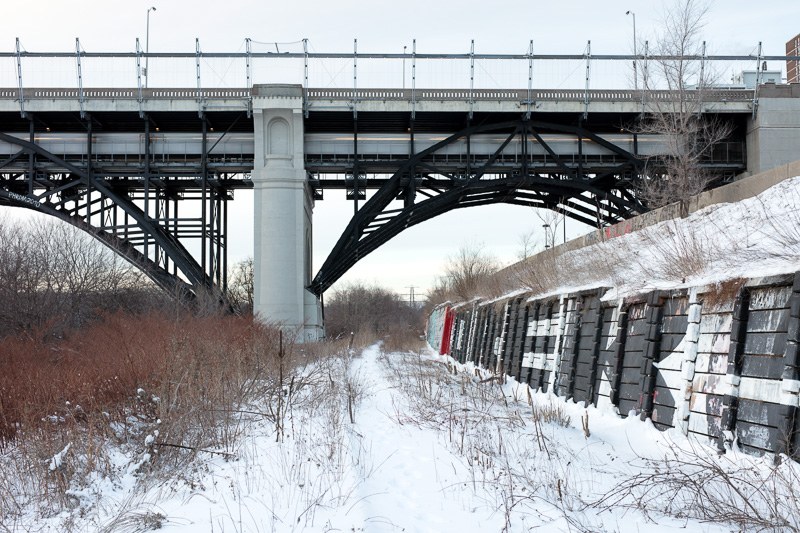
You could have gone off the Bloor Street viaduct
I could have been run down in the street
You could have got botulism anytime
I could have gone overboard into the seaAnything can happen
Bruce Cockburn
To put out the light,
Is it any wonder
I don’t want to say goodnight?
These words are from “Anything Can Happen” which appeared on Bruce Cockburn’s 1988 album, Big Circumstance. The very first in his litany of personal disasters is: going off the Bloor Street viaduct. Officially, it’s known as the Prince Edward Viaduct. Completed in 1918, it is 494 metres long and 40 metres above the Don River. In addition to supporting traffic, it supports the east/west subway line. If you look at the photo closely, you’ll see that I took it as a train was crossing. You can learn more about the Bloor Viaduct here.
Going “off the Bloor Street viaduct” used to be a fairly common event. In his novel, In the Skin of the Lion, Michael Ondaatje imagines the first such going “off the Bloor Street viaduct.” The incident he describes happens before the bridge was completed, so the two ends had not yet been joined:
Walking on the bridge were five nuns.
…
The nuns were moving towards a thirty–yard point on the bridge when the wind began to scatter them. They were thrown against the cement mixers and steam shovels, careering from side to side, in danger of going over the edge.Some of the men grabbed and enclosed them, pulling leather straps over their shoulders, but two were still loose. Harris and Pomphrey at the far end looked on helplessly as one nun was lifted up and flung against the compressors. She stood up shakily and then the wind jerked her sideways, scraping her along the concrete and right off the edge of the bridge. She disappeared into the night by the third abutment, into the long depth of air which held nothing, only sometimes a rivet or a dropped hammer during the day.
Then there was no longer any fear on the bridge. The worst, the incredible, had happened. A nun had fallen off the Prince Edward Viaduct before it was even finished. The men covered in wood shavings or granite dust held the women against them. And Commissioner Harris at the far end stared along the mad pathway. This was his first child and it had already become a murderer.
In real life, however, the bridge has murdered hundreds of people—so many, in fact, that it was the second most fatal standing structure in the world. The city decided to put a stop to the carnage by constructing a suicide barrier, and so, in 2003, the bridge was retrofitted with the “Luminous Veil.”
But does a physical barrier prevent suicide? Is this a valid way to think about prevention? Now, other musicians from Toronto wryly note:
Near where I live there’s a viaduct
Where people jump when they’re out of luck
Raining down on the cars and trucks belowThey’ve put a net there to catch their fall
Barenaked Ladies
Like it’ll stop anyone at all
What they don’t know is when nature calls, you go

A little further north of the Bloor Street viaduct is another bridge which spans the Don Valley. I passed by this afternoon and found a makeshift shrine—a memorial to Martin McMullan who, on November 8th, 2005, committed suicide at the age of 19.
Does a suicide barrier do any good? Or did the city of Toronto spend $5.5 million so that suicides could be dispersed to other bridges? Think what a boost local mental health care providers could have had with $5.5 million. Maybe it could have given them the resources to exercise some meaningful prevention.